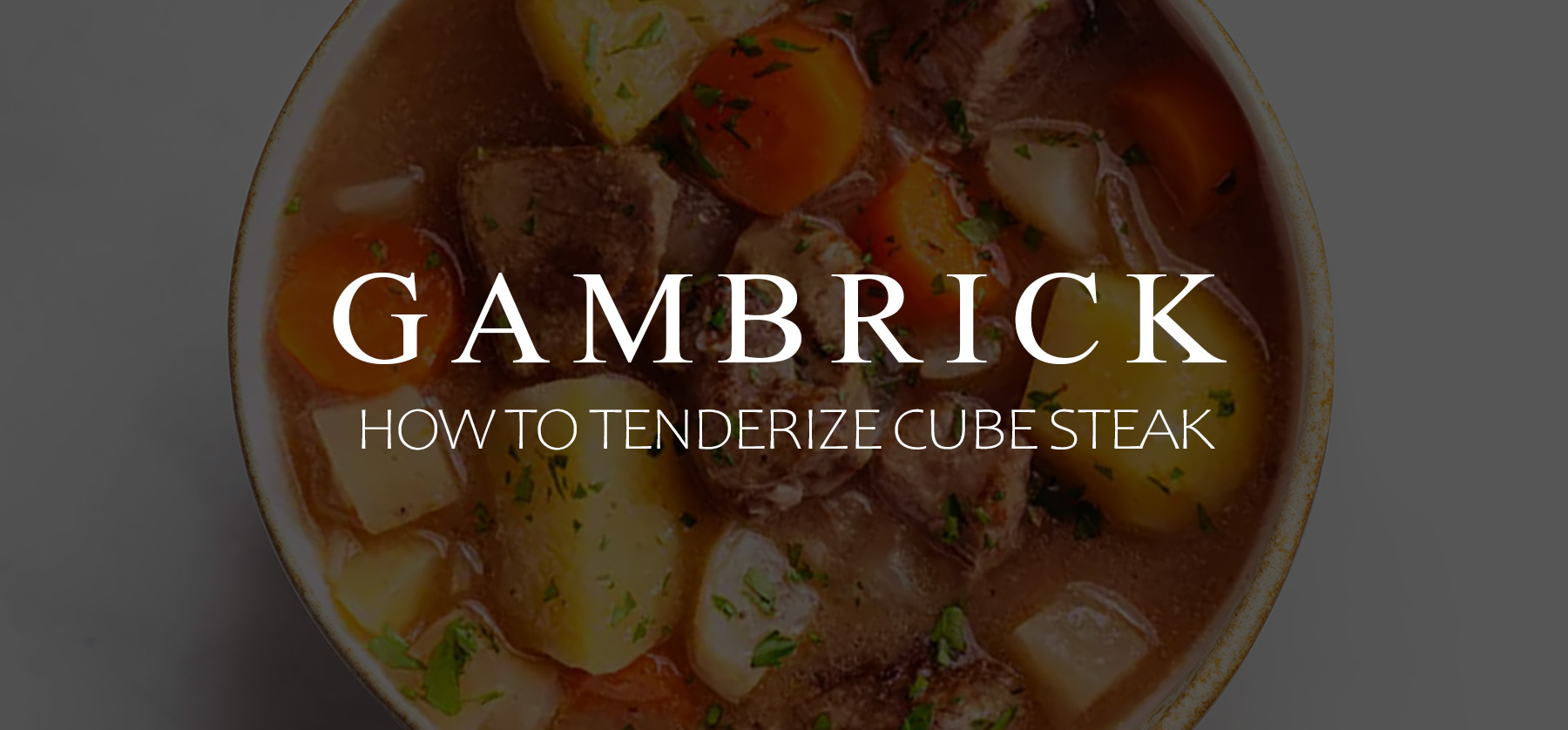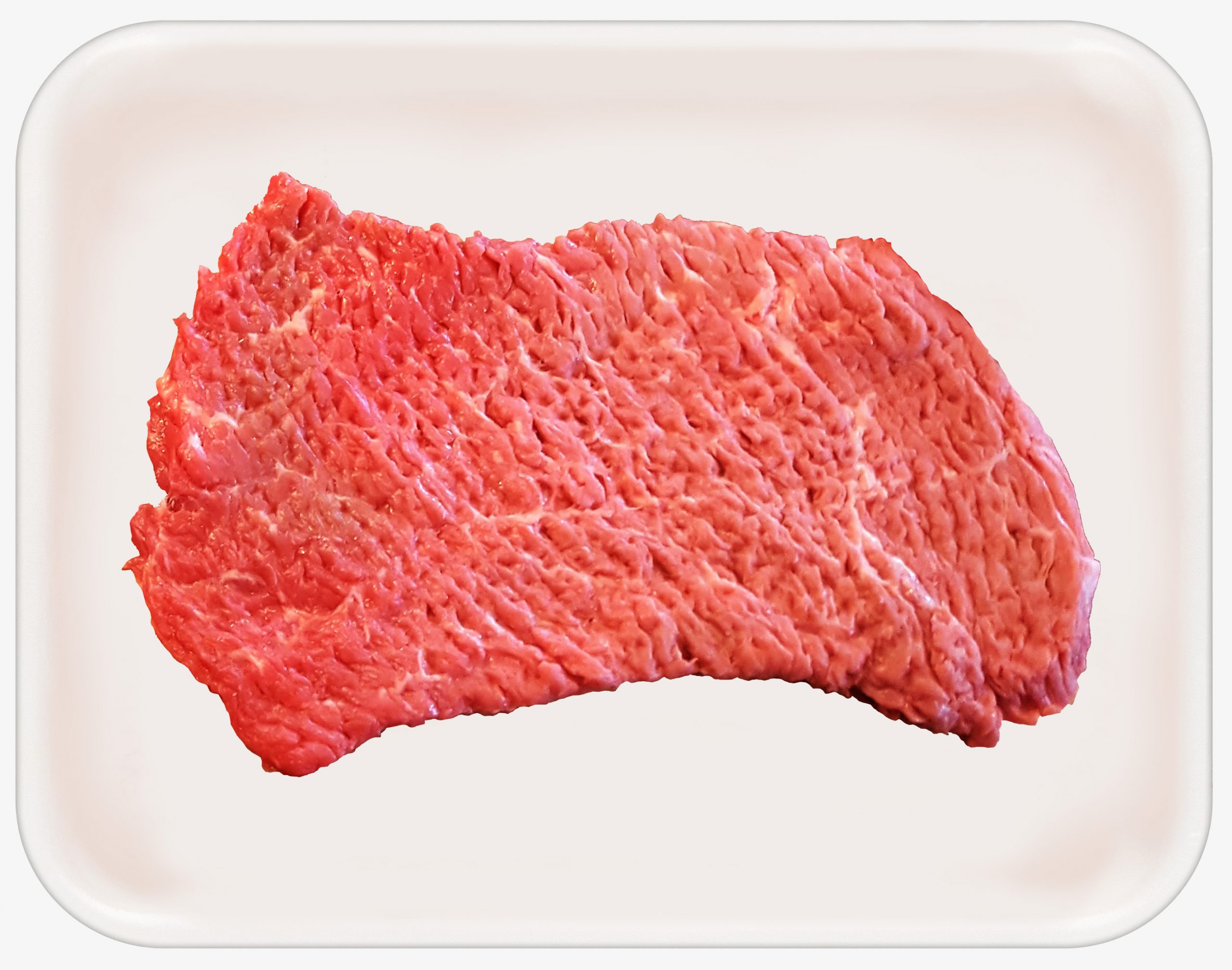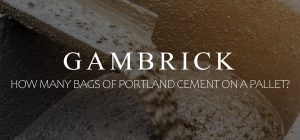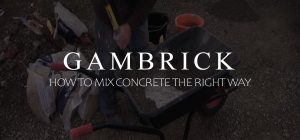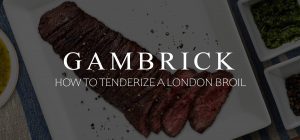How To Tenderize Cube Steak
Cube Steak is typically made from a round steak, sirloin, top round or round roast, which is found on the hind end of a cow. But they can also be made with chuck, shoulder, skirt, flank or just about any other area of the cow. They’re generally made from tougher cuts of meat that need tenderizing. The term Cube Steak refers to steak that’s been pre-tenderized by the butcher and not a specific cut of beef. Cube Steaks are thin cuts of meat that have been tenderized by a mechanical tenderizer before you buy them. The tenderizer leaves marks on both sides of the steak which makes them easy to spot. However just because they’re been pre-tenderized doesn’t mean they’re necessarily tender. The best way to tenderize cube steak is with a spiked mallet, an acid based marinade or by slow braising the meat.
Cube Steak is cut from tougher areas of the cow like flank, skirt and round roasts. Because these areas of the cow get exercised regularly, the meat is lean with very little marbling and a bit tough. But it’s very flavorful beef that’s inexpensive, which makes it perfect for steak dishes like tacos, fajitas, sandwiches or a stew.
Marinades and slow braising work especially well on cube steak because it has holes in it from the mechanical tenderizer. These holes allow marinades and other liquids to penetrate deeper into the meat which helps soften it.
Another way to tenderize cube steak is by slicing it properly. Always cut cube steak against the grain. This makes the meat easier to break up and chew.
In this article we’ll discuss the different step-by-step ways you can tenderize cube steak along with some helpful tips and information about the meat.
What Makes Cube Steak Tough & Chewy?
Steaks are actually muscles cut from a cow.
Muscles that get lots of exercise are denser with less fat marbling. This makes them tougher and harder to chew.
Areas of a cow that don’t get used as much exercise are softer with more marbling. This makes the meat more tender.
- Muscles at the top of the animal, around the backbone and ribs, don’t get much exercise so the meat is soft and tender with more marbling. These are your high-end steak cuts like prime rib, tenderloin, porterhouse, filet, etc. Unfortunately, these areas tend to be smaller which is why an entire cow only provides a few prime steaks. This increases the price of the meat.
- Working parts of a cow, like the legs, neck and lower muscles, get more exercise so the meat is tough and sinewy with more strips of fat and less marbling. There are more tough cuts on a cow than tender cuts so the price is much lower. These include Chuck, Brisket, Skirt, and Flank. This area is where cube steaks come from.
Muscle is made up of long strings of connective tissue called fibers. Surrounding the muscle fibers are a thin gelatinous substance called collagen and fat.
Tenderizing beef before you cook it breaks down and weakens these fibers which makes the meat softer and more tender.
Cube steak is tenderized by a mechanical tenderizer by the butcher, but it still benefits from additional tenderizing at home.
Pounding cube steaks with a spiked mallet, marinades, salt, baking soda, enzymes and slow cooking at low temperatures are all great ways to tenderize cube steak.
The Best Way To Tenderize Cube Steak Before You Cook
Cube steak is mechanically tenderized by the butcher before you buy it. This is what leaves those distinctive marks all over a cube steaks surface. But it still benefits from some additional tenderizing before you cook.
The meat is generally cut from tough and lean cuts of beef like skirt, flank, chuck or round roasts. Try to select the freshest steak you can with some amount marbling. Even among tough cuts of beef, some steaks are more tender than others.
- The best way to tenderize cube steak before you start cooking is with a meat tenderizing mallet. Pound the beef evenly on both sides. Pounding meat with a mallet breaks up tough muscle fibers and creates small dimples on the surface. These dimples allow juices to penetrate deeper into the meat which tenderizes even more. Don’t over pound cube steak because its already been mechanically tenderized by the butcher. Hit areas that got missed by the machine or places that still feel tough.
- Next, place your cube steak in an acid based marinade. All those holes created by the spiked mallet and mechanical tenderizer allow marinade to penetrate deeper into the meat. This makes it even more tender.
- You can also tenderize cube steak with salt, baking soda and enzymes which we’ll go over later in the article.
- Tenderize cube steak by cutting is properly. Always slice beef against the grain. This shorten muscle fibers which makes the meat easier to break down and chew.
- One of the best ways to tenderize cube steak is the cooking process called braising. Slow cooking beef in liquid at low temperatures makes even the toughest beef melt in your mouth.
Use multiple tenderizing methods together. Each method tenderizes beef in a different way which is why they’re so effective when used together.
How To Tenderize Cube Steak With A Mallet
Cube steak is mechanically tenderized by a butcher before you buy it. That’s what leaves those distinctive marks along the surface of the beef. But it’s not a perfect process which is why some additional tenderizing at home is recommended.
Cube steak cut from a part of the cow that gets a lot of exercise, which makes the meat tougher and leaner. Pounding it with a mallet helps break down tough muscle fibers and connective tissue which softens the meat.
Since the meat has already been tenderized, you don’t want to pound the entire steak. Only hit areas that were missed by the machine or feel especially tough.
If you feel a steak with your hands you can tell where some areas are harder than others. When you find a tough section pound it with your mallet.
Pounding steak with a spiked mallet not only tenderizes the beef but also creates small dimples on the surface. These dimples allow liquid to penetrate deeper into the meat which makes it more tender.
Here’s how to tenderize cube steak with a spiked meat mallet:
- Wrap the beef in waxed paper or a plastic bag. This will contain the meats juices as you hit it.
- Repeatedly pound the steak on both sides. This not only tenderizes the meat but also creates small dimples in the beef.
- The blunt force of a mallet helps break the bonds which hold muscle fibers together.
- Pounding the meat enhances the tenderizing effects of a marinade or stew stew by opening up the beef’s muscle fibers.
- Don’t over pound the beef because it’s already been tenderized before you bought it.
As you pound the steak, tough muscle fibers are broken down and torn apart. This makes the meat softer, more tender and easier to chew.
Tenderize Cube Steak With A Marinade
A great way to tenderize a tough cube steak is with an acidic marinade.
Not just any marinade will tenderize a steak, it has to contain some acid like lemon, lime or kiwi. Fruit is actually a really good tenderizer because many contain acids.
Acids break down proteins and tough connective tissue which tenderizes the meat. Lemon juice, wine, vinegar, beer and soda are all strong tenderizers. Even liquids like buttermilk and yogurt will help tenderize meat because of their acidic qualities.
Cube steak is mechanically tenderized by the butcher before you buy it which leaves behind lots of small holes. These holes allow marinade to penetrate deeper into the meat which helps soften it on the inside.
Here’s how you do it:
- Place your steak in a food-safe container and add your favorite marinade over it.
- Use a fork to turn the meat over.
- Both sides of the steak should be bathed in marinade.
- Place the steak in the refrigerator.
- Let the steak rest for at least 30 minutes and no more than 24 hours. I recommend marinating for 8 hours.
- Season.
- Start cooking.
Use a clean paper towel to blot the steak dry before cooking or sear it while still wet.
Pro Tip: When marinating with acids, use a non-reactive container like glass or Ziploc bags. A metal bowl can react with the acids giving your steak a strange metallic flavor.
How Long Should I Marinade Cube Steak?
The ideal time to marinate cube steak is 8 hours in the fridge. Turn the meat over every 2 to 4 hours to keep it drenched in marinade.
The maximum you can marinade steak for is 24 hours. Don’t go over 24 hours or it can become mushy.
When you’re done marinading, you can either pat dry the meat with a paper towel or sear it wet.
Always cut the meat across the grain. This makes it easier to break down and chew.
If you plan on braising or cooking cube meat as a stew, always braise it first. This turns the meat brown and adds more flavor. If you don’t sear meat before braising, it can turn an unattractive grey color.
The Best Way To Tenderize Cube Steak Is Braising
The best way to tenderize cube steak is by slow cooking in a small amount of liquid on low heat. This cooking process is called braising. Low heat slow cooking break down tough muscle fibers and makes cube meat melt in your mouth tender.
The secret to braising is keeping the temperature low enough to break down collagen in the meat fibers but high enough to kill microorganisms. A perfect temperature for braising is between 180 and 190 degrees Fahrenheit.
Always sear (brown) the meat quickly before starting to braise. This makes the meat brown, prevents it from turning grey in color and develops a great flavor.
- When braising on a stove top, this is considered a low simmer.
- A 300 to 325 degree Fahrenheit oven will accomplish a braise.
If you braise stew meat in the oven, preheat to 300 degrees. Use a roasting pan with a lid or a Dutch oven. Season as desired and add half a cup of water or beef broth to the pan. Put the lid on, and cook for about 2 – 4 hours.
Chefs Tip: Check the liquid every half hour or so and add more if needed. There should always be liquid in the bottom of the pan.
Braising is a slow cooking process both in the oven or on a stovetop. The meat needs time for the collagen to melt which produces extremely tender beef.
When you slow cook steak, the collagen surrounding tough muscle fibers melts which breaks apart and loosens the muscle.
Slow cook cube meat long enough and the meat will literally fall apart.
Heat and time are essential when slow cooking.
Slow Braising Cube Steak Makes It Tender
Slow braising cube steak can produce beef so tender it literally falls apart. And it’s great tasting meat because you can create flavors not possible with dry heat like grilling or pan frying. Try slow cooking your steaks with wine, spices, herbs and vegetables for even more flavor.
The key to this type of cooking is low heat for a long period of time.
Start by browning the meat on all sides over high heat in your Dutch oven or a cast iron skillet. This achieves a rich flavorful surface like the sear on a grill and prevents the beef from turning grey.
Remove the meat and deglaze the pan with liquid. Try wine, beer, broth or water. Add in your seasonings, veggies, onions, spices, potatoes, etc. Then put in the beef and cook with the lid on tight at around 300 °F for about 2 – 4 hours.
Check the level of your liquid every half hour or so. Add liquid as needed. For braising to be done right there must always be some liquid in the pot.
Make sure the lid stays on tight. If it’s open steam can release which dries out the meat.
Slow cooking in the oven generally works best, but a stovetop can also work as long as you keep the heat low and steady.
Braising Cube Steak On A Stove Top
Cube steak should be seared before braising. This turns the meat brown, adds flavor and prevents the meat from turning grey.
Put 2 or 3 tbsp. of oil in the pan or Dutch oven and heat over medium-high. Place the meat in as soon as the oil gets hot. Sear cube steak in small batches on all sides. Take each batch out of the pot before starting the next batch.
When all the meat is seared, put it into a Dutch oven and add 1/2 to 1 cup water of beef broth along with your other ingredients, vegetables and spices.
Bring to a boil, cover and turn down to medium-low.
Cook on a low simmer for 2 to 4 hours.
Check the liquid level every 30 minutes and adding more if necessary to keep liquid in the bottom of the pan.
Braising Cube Steak In The Oven
Pre-heat the oven to 300 degrees Fahrenheit.
Cube steak should be seared before braising. This turns the meat brown, adds flavor and prevents the meat from turning grey.
Place the meat in a single layer in a roasting pan or Dutch oven with a tight lid. Season as desired.
Add 1/2 cup of water or beef broth to the pan along with your other ingredients, vegetables and spices.
Place the lid on the pan and cook in the oven for 2 to 4 hours.
Check the liquid level every 30 minutes and adding more if necessary to keep liquid in the bottom of the pan.
Cook Cube Steak In A Stew
A stew is a little different than braising because it uses more liquid.
A stew uses enough liquid to completely cover the meat and vegetables in the pot. Like braising, stew meat should be seared before stewing to make the beef brown.
Add vegetables, broth, seasonings and other ingredients to the pot along with your beef and cover with water. Cook at a low simmer for 2 to 4 hours for a very tender meat stew.
To thicken up the broth, add 2 to 3 tbsp. of flour or 1 tbsp. of cornstarch to the liquid one-half hour before the cooking time is complete.
Sear Cube Steak Before Braising
After Cube Steak is tenderized, cut into cubes and seasoned, it should be seared.
Searing beef turns in brown, locks in juices, develops flavor and prevents it from turning grey. You should always sear a cube steak before braising or cooking a stew.
Sear the meat in a pan, pot, skillet or Dutch oven with a tablespoon of oil on medium-high heat.
Sear until the beef becomes brown on all sides. Your meat should have a dark brown crust and a glaze over the bottom of the pan. I always add seasoning when I sear to lock flavors deep in the meat.
Tip: Don’t put too much meat in the pot when searing. Add a single layer of meat at a time, and sear in small batches. The purpose of searing is to brown the outside of the beef, not to cook the inside.
Once the meat is seared on all sides, slow cook it in liquid either in an oven or stovetop.
Other Great Ways To Tenderize Cube Steak
There are plenty of great ways to tenderize cube steak before you start cooking. In addition to pounding the beef with a spiked mallet and cutting it into cubes against the grain, you can also try salt, enzymes, marinades and baking soda.
Each method of tenderizing beef works a little differently and some methods can be combined for even more tender beef.
Keep in mind that each of these meat tenderizing methods are done before you start braising or slow cooking the meat.
Tenderize Cube Steak With Salt
Coating cube steak with salt is another good way to tenderize it before you cook.
Don’t use regular table salt to tenderize a steak. It contains iodine which can give the meat a strange chemical flavor. It’s also too fine which makes it hard to wash off later. Table salt usually results in a weird tasting over salted steak. Use coarse kosher or sea salt instead.
Cube steak is mechanically tenderized by the butcher which leaves behind lots of small holes. These holes allow salt to penetrate deeper into the meat which helps soften it even more.
Tenderizing cube steak with salt is easy, here’s how:
- Sprinkle coarse salt generously over both sides of the steak.
- Allow the steak to rest for at least an hour.
- Rinse off excess salt.
- Dry the steak with a clean paper towel.
- Always cut the beef against the grain.
- Season the meat.
- Cook.
Salt draws out the steak’s natural juices which then dissolve the salt creating a brine solution. The brine then absorbs into the meat, adding in moisture while tenderizing.
In addition to tenderizing the meat, salting also gives it great flavor. Just remember not to add too much additional salt when you season the meat. It’s easy to over salt a steak that’s already been tenderized in salt.
When you tenderize steak with salt it will turn a little brown in color. Don’t be worried, this is normal and harmless.
Tenderize Cube Steak With An Enzyme Tenderizer
Natural enzymes are another good way to tenderize cube steak while also adding some additional flavor.
You can buy powdered meat tenderizer at the grocery store. Meat tenderizer contains a naturally derived enzyme powder. The enzyme most commonly used is papain, which comes from papayas or bromelain, which comes from pineapples. Sprinkle the steak with tenderizer and allow the enzymes to break down those tough meat fibers.
Meat tenderizing powder works fast. Usually the meat just has to sit with the powder on for a minute or two before cooking.
Use less salt on your steak if your enzyme-based tenderizer comes with salt in it.
If you prefer using fresh fruits instead of a powder, use a marinade of kiwis, pineapple, papaya and mango instead. These fruits are good sources of tenderizing enzymes and more natural than a powder.
The enzymes found in certain fruits do an excellent job of breaking down tough muscle fibers and connective tissue. They’ll tenderize the meat making it softer and less chewy.
Cube steak is mechanically tenderized by the butcher which leaves behind lots of small holes. These holes allow enzymes to penetrate deeper into the meat which helps soften it even more.
When enzyme tenderizers are used too long the steak can get mushy on the outside. So only keep them on for a few minutes.
- If you use a powder, let it sit for just a minute or two before cooking.
- If you use the fruits, let the steak marinade for about an hour.
Pro Tip: When marinating with enzymes, always use a non-reactive container like glass or Ziploc bags. A metal bowl can react with the enzymes giving your steak a strange metallic flavor.
How To Quickly Tenderize Cube Steak With Baking Soda
One of the fastest ways to tenderize a tough cube steak is with a Baking Soda bath. Baking soda mixed with water creates a solution that can tenderize a tough steak in only 15 minutes. Baking soda causes the steak’s pH level to increase while neutralizing acid found in the meat.
As pH levels rise toward the outside of the meat, proteins on the inside loosen their bonds. This results in a more tender and juicy steak.
Once you’re done tenderizing the meat, thoroughly rinse it off before adding spices and cooking. You don’t want to cook the meat if it still has baking soda on it.
Even though a baking soda bath can quickly tenderize a tough steak, it doesn’t do much for its taste. Add all your spices after the meat is removed from the baking soda and rinsed.
Here’s how to create a baking soda bath for your cube steak:
- Dissolve 1 tablespoon of baking soda in a ½ cup of water for every 12 ounces of steak.
- Place your meat in the solution and soak it for 15 minutes.
- Rinse with water and pat dry.
- Cut and season the meat.
- Start cooking.
Remember, a baking soda bath is a fast and easy way to tenderize tough cuts of beef. But it doesn’t add any flavor like a marinade, salt or enzymes do. Spice the meat after its been removed from the bath, cut and rinsed.
Tenderize Cube Steak By Slicing It Against The Grain
Another way to improve the tenderness of cube steak is by slicing it properly. Always slice meat against the grain. This shortens tough muscle fibers which makes the meat easier to break down and chew. Slicing meat with the grain makes it harder to break apart and chewy.
Are You Supposed To Tenderize Cube Steak Before You Cook?
Cube steak is mechanically tenderized by the butcher before you buy it, but it’s still a tough cut of beef that should be tenderized before you cook. Use a spiked meat mallet to pound the beef in especially tough areas or anywhere missed by the butcher. Follow up with a marinade, enzymes, salt baking soda.
Pound the steak on both sides hard enough to create dimples in the meat. These dimples will break up tough muscle fibers which makes the beef softer. It also allows liquids to penetrate deeper into the steak as you cook it.
Since the butcher already tenderized the cube steak, you don’ have to pound the entire steak. Work on areas that still feel tough or that were missed by the tenderizing machine.
Once you’re done pounding, soak the meat in a marinade or use enzymes, salt or baking soda to further tenderize the meat.
When it’s time to slice the meat, make sure to do it against the grain. This shortens muscle fibers, making the meat easier to break down and chew.
By tenderizing before you cook and properly slicing it, a cube steak can become a quite tender and juicy cut of beef. Especially if you slow braise or turn it into a stew.
How Do You Cook Cube Steak So It Isn’t Tough?
Cube steak is typically thin, lean and tough meat that’s been tenderized by the butcher. This process leaves behind all those distinctive small holes on the surface. If you want to cook a cube steak so that it isn’t tough, the secret is tenderizing it before you cook followed by braising or turning it into a stew.
Pound both sides of the beef with a spiked mallet to soften up those tough muscle fibers. Then soak the meat in a marinade or use salt, enzymes or baking soda to further tenderize the meat.
Next, cut the meat against the grain into small cubes. Then season and sear the meat and start slow cooking.
Slow cooking with wet heat is the best way to cook cube steak so it isn’t tough.
- Start by browning the meat on all sides over high heat in your Dutch oven or a cast iron skillet. This achieves a rich flavorful surface like the sear on a grill.
- Remove the meat and deglaze the pan with liquid. Try wine, beer, broth or water.
- Add in your seasonings, veggies, onions, spices, potatoes, etc.
- Then put in the beef and cook with the lid on tight at around 300 °F for about 2 – 4 hours.
- Check the liquid every 30 minutes or so and add more as needed. There should always be liquid in the pot when braising.
When cube steak is slow cooked on low wet heat it becomes so tender you can cut it with a fork.
How To Tenderize Cube Steak Fast
The fastest way to tenderize cube steak is with a spiked mallet.
Pound both sides of the meat until dimples appear. This can be done in as little as a minute. Pounding a cube steak with a spiked meat tenderizer break up tough connective tissue and muscle fibers which softens the beef.
Since cube steak was already mechanically tenderized by the butcher, you don;t have to pound the entire steak. Work on especially tough areas or places missed by the tenderizing machine.
Next, rub some meat tenderizer on the meat. Meat tenderizers contain enzymes which soften the meat while it cooks. They’re faster than a marinade but produce a similar effect. This can be done in as little as a few minutes.
A pounding combined with a meat tenderizer can tenderize a tough steak in as little as 2 – 3 minutes.
Summary: How To Tenderize Cube Steak
Cube Steak is typically made from a round steak, sirloin, top round or round roast, which is found on the hind end of a cow. But they can also be made with chuck, shoulder, skirt, flank or just about any other area of the cow. They’re generally made from tougher cuts of meat that need tenderizing. The term Cube Steak refers to steak that’s been pre-tenderized by the butcher and not a specific cut of beef. Cube Steaks are thin cuts of meat that have been tenderized by a mechanical tenderizer before you buy them. The tenderizer leaves marks on both sides of the steak which makes them easy to spot. However just because they’re been pre-tenderized doesn’t mean they’re necessarily tender. The best way to tenderize cube steak is with a spiked mallet, an acid based marinade or by slow braising the meat.
Cube Steak is cut from tougher areas of the cow like flank, skirt and round roasts. Because these areas of the cow get exercised regularly, the meat is lean with very little marbling and a bit tough. But it’s very flavorful beef that’s inexpensive, which makes it perfect for steak dishes like tacos, fajitas, sandwiches or a stew.
Marinades and slow braising work especially well on cube steak because it has holes in it from the mechanical tenderizer. These holes allow marinades and other liquids to penetrate deeper into the meat which helps soften it.
Another way to tenderize cube steak is by slicing it properly. Always cut cube steak against the grain. This makes the meat easier to break up and chew.
If you have any questions about tenderizing steak, email any time.
